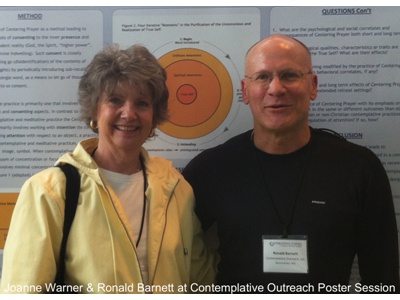Ronald L. Barnett, Ph.D.
member of the Circle of Service of Contemplative Outreach, Ltd.
As one of 24 co-sponsors, Contemplative Outreach, with the primary organizer, Mind and Life Institute (MLI), convened for the first International Symposia for Contemplative Studies in Denver Colorado, April 26-29, 2012. MLI was created in collaboration with His Holiness the Dalai Lama who has had a longstanding interest in how science can both serve humanity and create a better understanding of the world, including the interconnectedness of all life.
The purpose of the symposia was “to bring together academics and other interested persons for presentation, discussion and networking in the fields of contemplative basic science, contemplative clinical science, contemplative philosophy and humanities, contemplative education, and those domains of research and scholarship” (MLI).
 Each day, approximately 700 attendees – a number that far exceeded organizer expectations – from the U.S., Canada, Europe, Africa, South America, and Asia attended keynote addresses, master lectures, workshops, organized and individual papers, symposia, and poster presentations. The range of topics was also diverse and numerous.
Each day, approximately 700 attendees – a number that far exceeded organizer expectations – from the U.S., Canada, Europe, Africa, South America, and Asia attended keynote addresses, master lectures, workshops, organized and individual papers, symposia, and poster presentations. The range of topics was also diverse and numerous.
Topics ranged from neuroscience brain imaging research of meditators and compassion studies, to lessons for developing a cross-disciplinary, collaborative, university-based contemplative studies program, to the nature of consciousness and to many clinical studies on the practice of mindfulness, including its relationship to anxiety disorders, physical pain, maternal perinatal depression, eating behavior, emotional resilience and management of real-world stressful situations, e.g., military predeployment. In sum, there were over 177 oral presentations and 122 poster presentations given during the three days.
Each morning attendees were invited to attend yoga followed by meditation with a teacher from a different contemplative tradition, including Tibetan Buddhism and Christian with Bro. David Steindl-Rast, PhD, OSB. These periods of both guided and non-directed silent meditation were inspiring in their focus and depth of silence as attendees from different meditative and religious backgrounds consented in a spirit of welcoming to the guidance of the teacher of the day.
Contemplative Outreach, ‚Äúa community (global) of individuals and small faith communities committed to living the contemplative dimension of the Gospel in everyday life‚Äù, was also represented at the symposia. It developed and presented a poster entitled, “The Christian Contemplative Tradition: Considerations for Research,‚Äù co-authored by Ronald Barnett, Gail Fitzpatrick-Hopler, David Frenette and Thomas Keating. The turnout for this poster presentation exceeded expectations and so it was most fortunate that Joanne Warner of Contemplative Outreach of Colorado was able to join Ron in engaging interested persons and answering questions. It was one more instance of the spirit of collaboration that characterized the symposia (Thank you Joanne!).
Other observations of the symposia include:
 the evidence base for the effectiveness of mindfulness practice as a type of contemplative practice in clinical areas is considerable and growing, and basic scientific understanding of the mind and contemplative practice has a beginning foundation;
the evidence base for the effectiveness of mindfulness practice as a type of contemplative practice in clinical areas is considerable and growing, and basic scientific understanding of the mind and contemplative practice has a beginning foundation;- many young adults attended;
- while the symposia was scientific in its focus, there emerged within that focus a degree of inter-religious dialogue, communion and understanding;
- there is considerable interest at some universities in establishing on campus, collaborative contemplative education studies and research activities;
- the movement from a dualistic to a unitary perspective was evident in the meditation sessions, informal discussions and speaker/audience interactions;
- while Christian contemplative practice and research were considerably less in evidence than other traditions, they were nonetheless visible, appreciated and provided another, complimentary “window” into the human person and the contemplative dimension of life.
- the symposia was historic in convening a broad array of individuals from different academic disciplines and research orientations, and represents a strong pulse in the application of science to better understanding contemplative practices;
- the opportunity to further understanding of Christian contemplation from the perspective of science is as yet unrealized, though a real possibility, including ongoing networking with interested parties and attendance at future research meetings and symposiums.
Finally, a number of videotaped presentations and all of the session abstracts are available at http://contemplativeresearch.org/.
If you have any questions about the symposia or contemplative research, please contact Ronald Barnett.





